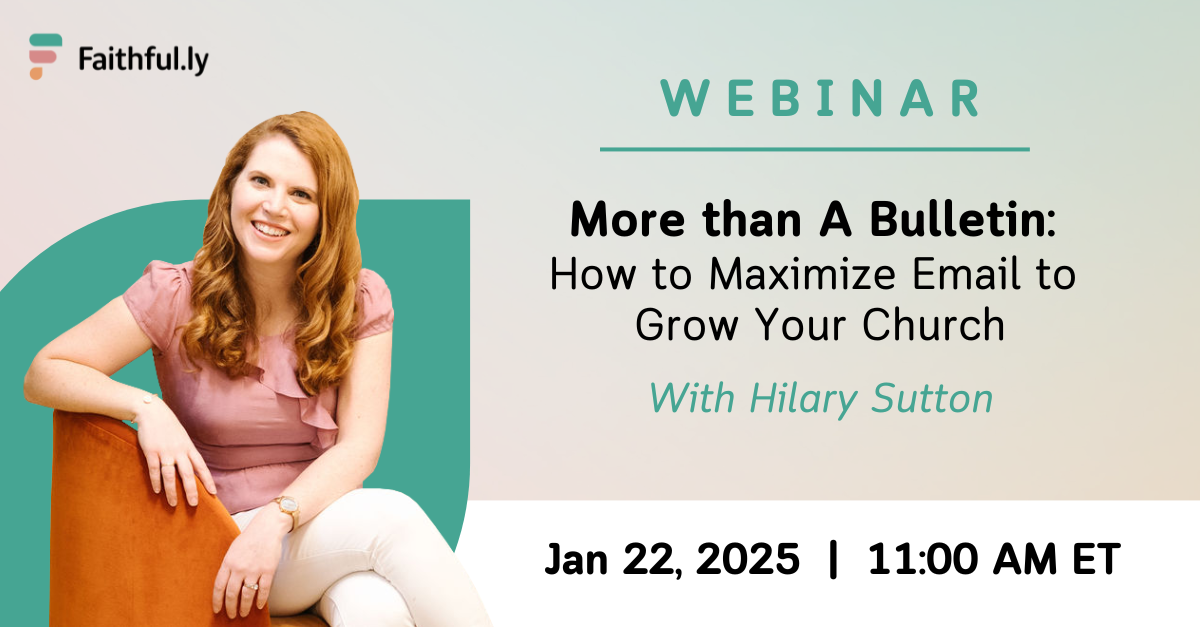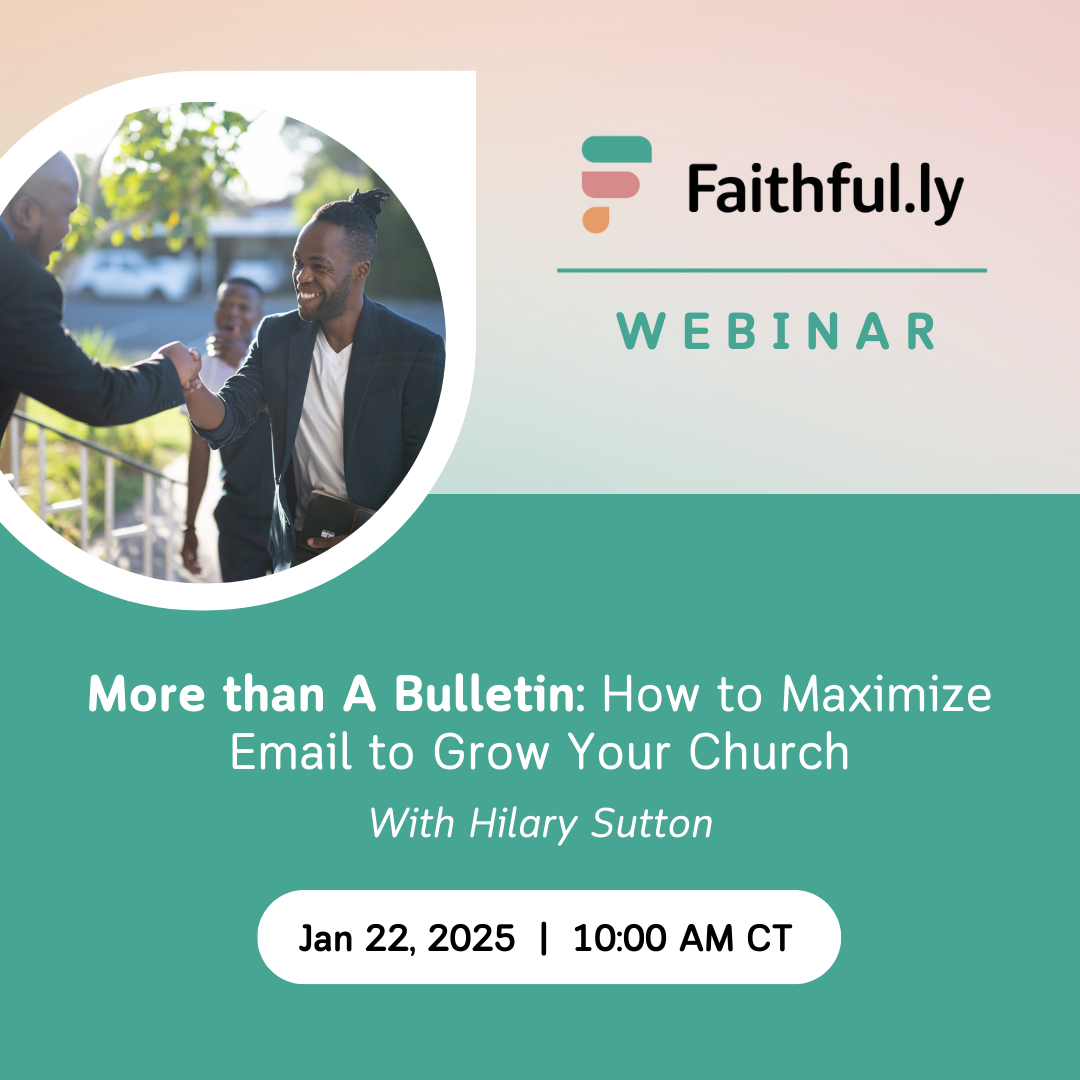2 Ways to Improve Your Church Email Marketing
How do you feel when you get a piece of mail that
- is addressed to you
- clearly handwritten
- isn't from a company
- isn't your birthday or holiday
I don't know about you, but when I get a card or letter that isn't like that, I get excited. Heck, part of the reason I love my birthday is getting mail in the mail. Sure, the birthday emails from corporations are nice because who doesn't love a free Chick-fil-A sandwich?
But getting something customized for me by someone I care about means more than that.
What if I told you you could recreate that feeling in others through your church's email?
What if you could excite people to open their inbox in the morning? What if instead of checking work email or news, people opened your email first to be spiritually nourished and spend time with God.
Email marketing is (in my opinion) the most underutilized content distribution platform for churches. And by the time you're done reading, you'll want to start using it.
Why Email Marketing is Crucial for Your Church
"I think churches are thinking way too narrowly about how to use email and how to communicate what matters," said Hilary Sutton, founder of Faithful.ly. "There's such an incredible opportunity to use email to deepen relationships and understanding."
While you might invest in social media because "that is where the people are," you are having to compete against the noise. People can move from your content to the next in the blink of an eye.
But with email, it's your email against bills, spam, and businesses promoting themselves. You can be a light in someone's inbox instead of something they scroll past.
As Hilary said, email marketing is crucial for your church because it can deepen relationships—not just with your congregation but also with totally strangers.
2 Things to Make Your Church Emails Stand Out
Your email is more than a "newsletter" that acts as a digital bulletin, and you should treat it as such. There are two big things you can start today that will make people want to read your church emails: segment the list and automate emails.
Segment Your List
Mailchimp defines email segmentation as "the process of dividing and separating email subscribers into groups or segments based on criteria."
For your church, this looks like a number of traits. You could segment emails based on:
- Age and Gender
- Children and their ages
- Ministries they are active in
- Whether they serve or not
- Events they've attended or not
Segmenting is essential because it gives people a good experience and impression of your church on more than just Sunday. It shows you care and are diligent.
For example, around Thanksgiving in 2024, I got an email promoting a Young Adults "Friendsgiving." However, it was not from the church I attended. It came from a church I attended 3 years earlier and hadn't returned since.
The email came out of the blue. I hadn't received any other communication from them via email since I joined a different church. If I hadn't been in marketing and understood the plight of managing emails, I probably would've been (more) annoyed.
Automate Emails
The second thing you can start to implement is email automation. You experience this daily with email promotions. Businesses will set up automated emails if you buy certain products. Suppose you sign up for a newsletter or to gain access to a digital product. In that case, you will likely be put in an automated email sequence.
Those aren't always bad. They can be annoying, but only if you aren't interested in the subject of the emails.
For your church, automated emails could look like:
- A series of 3-5 welcome emails that get sent when you add a first-time guest's email to your ChMS
- An educational course on who Jesus is, salvation, etc.
- A couple emails for families who visited for an Easter Egg hunt event or other outreach event
Your days are already too busy to send more emails. You already have to plan meetings and coordinate times to pastor others. Automated emails free up your time to do what you love most: helping others grow in their faith.
What Email Segmentation and Automation Look Like for Churches
How can you practically start with email segmentation and automation for your church? During my interview with Hilary, we laid out some practical steps and strategies you could use to get started. (She's also having a workshop about it on January 22nd).
Let's pretend that you want more people to attend your Sunday service after interacting with your church at an outreach event.
"With email in particular, think about the experience of even getting on the list to start with," she said. "For example, segment from people who've come to an outreach event… what is that first touch point that people have when they're giving you their email address?"
Think about what the email says, looks, and feels like. The initial email is crucial, especially when you create an automated series behind it.
"I'd love to see in the first email a form or clickable links for the recipient to say, 'I want to learn more about women's ministry or missions or local outreach or whatever,' Hilary said." If you optimize that experience with your welcome team, then you should have a digital version of that that continues the experience."
You invest your time and effort in having cheerful, welcoming people greet guests on Sunday. So, let your email do the same. Just like you think through the experience of a first-time guest, think about the digital experience you want them to have. Give a good first impression in person and in their inbox.
Other Church Email Marketing Ideas
Email should be used for more than guest follow-up. Your church can implement many different uses for email this year.
Testimonies
"There should also be impact stories at least once a month, if not weekly," Hilary said. "There can be a lot of incredible things that God is doing through ministries in your church that you never know about unless they speak on stage on Sunday."
People can debate theology, but that can debate how God moves in your life. People's Jesus story inspires and encourages others to move closer to him.
Devotionals and E-Books
Repurpose your sermons to be daily email devotionals. Tools like Pulpit AI and Church.Tech makes it easy for you to have sermon-inspired email devotionals.
Additionally, you can use these tools to repurpose the sermons into e-books. Each sermon could be a chapter, or each point in a sermon a chapter.
"Repurpose some sermons and turn them into a digital download," Hilary shared. This could be an e-book. It could be a daily devotional. It could be a devotional calendar tailored to someone in a particular segment of your email list.
Educational Email Courses
(This is my favorite idea)
What if you could teach your congregation or strangers some of the core tenets of the faith?
- Who is Jesus?
- What/who is the Trinity?
- How to Start Reading My Bible?
An educational email course is an automated sequence of emails over 3-5 days designed to teach one key topic. I've seen people use it in business to get more customers and sell more products. You can use it to disciple more people and teach more robust sermons.
Where You Should Start in Your Email Marketing Strategy
I know I've thrown a lot at you with this blog post, especially if you've never considered email marketing. Before you start creating email content, consider Hilary's advice.
"Ask yourself, 'Why are we doing what we're doing, and is it working?'" she said. "Before you add anything to the mix or double down on something, look at how it's performing."
Another way to look at it is if you were to completely clear everything and start from square one, what would you strategically put back on the table?
You should start leveraging your email (and texting, for that matter). There are too many ways you can use it to bring people closer to Jesus.
"I hope churches will embrace technology to drive discipleship and help people get plugged in," Hilary said.









